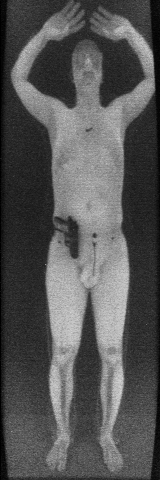White Devil
Registered
4
What's it going to take america? When are you going to get fed up with the feds and thier bullsh*t? Oh, I forgot, thie country is loaded with a bunch of submissive cowards.
Just Imagine when pictures of you're nude body show up on the internet so people can mock you. Or just so the feds can keep pictures of your naked body on file for fu*k knows what.

The agency in charge of the nation's air security expects later this year to begin using a controversial X-ray machine that will show airport screeners a clear picture of what's under passengers' clothes --whether weapons or just bare skin.
Screeners plan to test the "backscatter" machines at several U.S. airports, the Transportation Security Administration (TSA) say
s. The refrigerator-sized machines are considered a breakthrough in scanning technology but have been
labeled "a virtual strip search" by the American Civil Liberties Union. (Related story: Airports test 'futureworld' devices)
Security workers using the machines can see through clothes and peer at whatever may be hidden in undergarments, shirts or pants. The images also paint a revealing picture of a person's nude body.
The devices can potentially be used to screen hundreds of millions of air travelers each year, although TSA says more study is needed to determine how the devices may be used at U.S. airports. The agency declined to say when and where it expects to test the machines.
Backscatter technology has been waiting on the sidelines for nearly four years but seems poised now to move to the forefront of aviation security. The machines are already used by U.S. Customs agents at 12 airports to screen passengers suspected of carrying drugs. They're also get
ting
a test run at a terminal in London Heathrow Airport, the first major airport to use them.
The ACLU says the scanners invade pe
rsonal privacy. "This leads directly to a surveillance society," says Barry Steinhardt, who runs the group's technology program.
But Homeland Security Secretary Michael Chertoff told a Senate subcommittee last month that he wants to employ the technology and doesn't want an "endless debate" over privacy issues.
Security consultant Douglas Laird says the machines are essential to spot explosives, which aren't detected by metal detectors.
The $100,000 machines bounce low-radiation X-rays off a person's skin to produce photo-like computer images of metal, plastic and organic materials hidden under clothes, says American Science and Engineering. The TSA is testing its BodySearch machine.
http://www.u
satoday.
com/travel/news/2005-0...ttomstrip_x.htm
What's it going to take america? When are you going to get fed up with the feds and thier bullsh*t? Oh, I forgot, thie country is loaded with a bunch of submissive cowards.
Just Imagine when pictures of you're nude body show up on the internet so people can mock you. Or just so the feds can keep pictures of your naked body on file for fu*k knows what.

The agency in charge of the nation's air security expects later this year to begin using a controversial X-ray machine that will show airport screeners a clear picture of what's under passengers' clothes --whether weapons or just bare skin.
Screeners plan to test the "backscatter" machines at several U.S. airports, the Transportation Security Administration (TSA) say
s. The refrigerator-sized machines are considered a breakthrough in scanning technology but have been
labeled "a virtual strip search" by the American Civil Liberties Union. (Related story: Airports test 'futureworld' devices)
Security workers using the machines can see through clothes and peer at whatever may be hidden in undergarments, shirts or pants. The images also paint a revealing picture of a person's nude body.
The devices can potentially be used to screen hundreds of millions of air travelers each year, although TSA says more study is needed to determine how the devices may be used at U.S. airports. The agency declined to say when and where it expects to test the machines.
Backscatter technology has been waiting on the sidelines for nearly four years but seems poised now to move to the forefront of aviation security. The machines are already used by U.S. Customs agents at 12 airports to screen passengers suspected of carrying drugs. They're also get
ting
a test run at a terminal in London Heathrow Airport, the first major airport to use them.
The ACLU says the scanners invade pe
rsonal privacy. "This leads directly to a surveillance society," says Barry Steinhardt, who runs the group's technology program.
But Homeland Security Secretary Michael Chertoff told a Senate subcommittee last month that he wants to employ the technology and doesn't want an "endless debate" over privacy issues.
Security consultant Douglas Laird says the machines are essential to spot explosives, which aren't detected by metal detectors.
The $100,000 machines bounce low-radiation X-rays off a person's skin to produce photo-like computer images of metal, plastic and organic materials hidden under clothes, says American Science and Engineering. The TSA is testing its BodySearch machine.
http://www.u
satoday.
com/travel/news/2005-0...ttomstrip_x.htm




